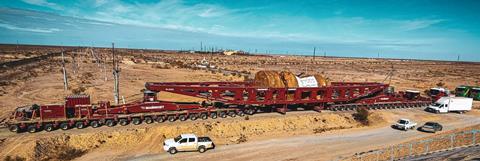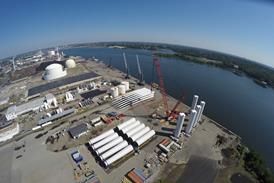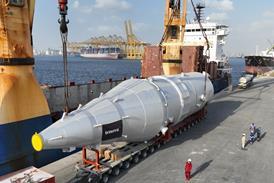Mammoet has provided transport engineering services for a 1.5G W combined-cycle gas turbine CCGT power plant in Uzbekistan, which included a 2,200 km road haul.

Globalink Logistics contacted Mammoet to assist with the transportation of heavy items for the construction of a new power plant in the city of Shirin. Developed by ACWA Power, the CCGT power plant is part of the government’s plan to improve efficiency and capacity of its electricity production, while boosting economic growth and reducing environmental impact.
The landlocked country usually relies on Caspian Sea gateways for receiving out-of-gauge (OOG) items and for this project Kazakhstan’s port of Bautino was selected – more than 2,000 km from the ultimate project site. A team of engineers, headed up by Mammoet operations manager Marek Lysko, planned how to get the cargoes, weighing between 130-517 tonnes, from port to plant.
“We call [Bautino] Mammoet Port, because it’s purely operated by us,” said Ali Yoldashov, Mammoet’s regional manager – Caspian. “Bautino is a seaport and has sufficient draught, unlike other ports in the Caspian Sea. The ground-bearing pressure capacity on the port is sufficient enough to handle oversized cargo on the crane outreach. It also gave us the possibility to make Customs clearance, and practically unlimited storage space. We established it was the only solution.”
Most of the OOG items would be loaded straight from vessel to trailer and then driven to the site directly from the port. However, for the five heaviest items, most notably the gas turbines, this was not possible.
“The gas turbines can be transported on a rigid set of conventional trailers having large axle numbers, but because the load capacity of the majority of the existing bridges in Uzbekistan, the load spreading calculation entered the discussion. Everybody understood that this solution wouldn’t be suitable for the transportation of these heavy units on the bridges. What we had to do was distribute the weight, practically, by hanging the cargo between two separate trailers at the front end and rear end,” Yoldashov explained.
Even with this solution and 480 tires distributing the load, there were still some bridges unable to handle the axle loads. Mammoet added an additional eight axles (64 tires) directly under the hanging cargo to cross these critical bridges. Adding and removing additional axles was a challenge in terms of engineering and operations but proved to be the only way to protect the team, equipment, cargo and infrastructure. This required a specialist piece of Mammoet equipment: the AL600 Girder Frame.
“The AL600 was designed and built from high-strength steel to keep the self-weight as low as possible,” Lysko stated. “It has a very good ratio of self-weight to capacity of cargo. This means it’s light but flexible and strong. This was an important factor for the Uzbekistan bridges, which have really low lenience for axle loads.” The AL600 sits on two independent trailers, towed by prime movers, and its modular design allows for up to 2 sets of 20 axle lines to carry exceptional weights, which are distributed using a load spreader system.
Finally, the project site couldn’t accommodate the size of the AL600 convoy that spanned more than 100 m in length, so the cargo was transferred onto SPMTs for the stage of the journey.
Commenting on the project’s technicalities, Lysko concluded: “The customer took advantage of the combination of Mammoet’s specialist equipment, and engineering and logistics expertise to overcome obstacles and bottlenecks enroute. However, I think the biggest benefit for our customer was the end-to-end logistics solution that was provided by a single company, instead of having to coordinate multiple suppliers. This improved overall efficiency and alignment of delivery schedules, mitigated risks and enhanced safety.”
















